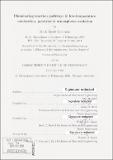| dc.contributor.advisor | Jesse H. Kroll and William H. Green. | |
| dc.contributor.author | Goldman, Mark Jacob. | en_US |
| dc.contributor.other | Massachusetts Institute of Technology. Department of Chemical Engineering. | en_US |
| dc.date.accessioned | 2022-01-25T16:14:36Z | |
| dc.date.available | 2022-01-25T16:14:36Z | |
| dc.date.copyright | 2020 | en_US |
| dc.date.issued | 2020 | en_US |
| dc.identifier.uri | https://hdl.handle.net/1721.1/139720 | |
| dc.description | Thesis: Ph. D., Massachusetts Institute of Technology, Department of Chemical Engineering, February, 2020 | en_US |
| dc.description | Cataloged from the official PDF of thesis. | en_US |
| dc.description | Includes bibliographical references (pages 193-227). | en_US |
| dc.description.abstract | Reaction mechanisms are key to developing many technologies that could aid in addressing climate change. Evaluating how emissions transform in the atmosphere, obtaining more efficient combustion engines, and finding a way to store transient renewable energy all rely on accurate chemical mechanisms. This thesis spans this space by refining basic reaction rate theories, combining information and techniques from various fields to advance knowledge about atmospheric and combustion chemistry, and developing computational tools to model pyrolysis for isotopic analysis. Having a solid foundation for reaction kinetics is necessary to get accurate kinetic rates. The first chapter corrects a longstanding issue in transition state theory by determining the proper symmetry in reactions with identical reactants and estimating the error from taking incorrect approach. The next chapter then applies transition state theory to develop high pressure limit and pressure-dependent kinetics for peroxy radicals from isobutanol, a potential bio-derived fuel. To fully understand the behavior of oxygenated bio-based fuels, this thesis utilizes these isobutanol rate coefficients along with other estimated and measured rate coefficients to examine how peroxy radicals react across a range of temperatures, pressures, functional groups, and NO concentrations. This wide perspective elucidates why certain conditions cause pathways in combustion chemistry to start impacting atmospheric systems and vise versa. Peroxy reactions in the condensed phase also matter, so the subsequent chapter addresses this by developing a more accurate framework to simulate oxidation of small particles in the atmosphere. Both of these chapters help improve predictions on how changing emissions impacts the environment. The final chapter of this thesis describes the creation of a tool to help assess the origin of volatile fuels by applying combustion-based automatic mechanism generation in order to help measure the exact isotopic positions within molecules. Overall, these projects solve pieces of a larger climate problem which will require, among other things, large-scale technological, political, and social changes. | en_US |
| dc.description.statementofresponsibility | by Mark Jacob Goldman. | en_US |
| dc.format.extent | 251 pages | en_US |
| dc.language.iso | eng | en_US |
| dc.publisher | Massachusetts Institute of Technology | en_US |
| dc.rights | MIT theses may be protected by copyright. Please reuse MIT thesis content according to the MIT Libraries Permissions Policy, which is available through the URL provided. | en_US |
| dc.rights.uri | http://dspace.mit.edu/handle/1721.1/7582 | en_US |
| dc.subject | Chemical Engineering. | en_US |
| dc.title | Illuminating reaction pathways in low-temperature combustion, pyrolysis & atmospheric oxidation | en_US |
| dc.type | Thesis | en_US |
| dc.description.degree | Ph. D. | en_US |
| dc.contributor.department | Massachusetts Institute of Technology. Department of Chemical Engineering | en_US |
| dc.identifier.oclc | 1293008797 | en_US |
| dc.description.collection | Ph. D. Massachusetts Institute of Technology, Department of Chemical Engineering | en_US |
| dspace.imported | 2022-01-25T16:14:36Z | en_US |
| mit.thesis.degree | Doctoral | en_US |
| mit.thesis.department | ChemEng | en_US |
